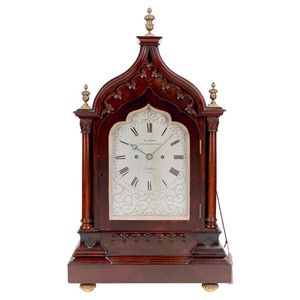William IV Mahogany Bracket Clock by Dent of London
A William IV mahogany cased bracket clock, the movement by Dent of London, the silvered dial with Roman hours within engraved spandrels and face inscribed: E. J. Dent, / 54 / Royal exchange / London / 1220. The case of ogee outline with brass urn finials and flanked by a pair of engaged columns on a moulded base with reeded bun feet, height 64 cm, Other Notes: Dent was a London manufacturer of luxury clocks and watches, founded by Edward John Dent. Dent began making watches in 1814, although the Dent triangular trade mark was not registered until 1876. A notable success for the Company was winning the contract to make the clock for the new palace of Westminster in 1852, which became known as Big Ben.
You must be a subscriber, and be logged in to view price and dealer details.
Subscribe Now to view actual auction price for this item
When you subscribe, you have the option of setting the currency in which to display prices to $Au, $US, $NZ or Stg.
This item has been sold, and the description, image and price are for reference purposes only.
- William Iv - William IV was King of the United Kingdom and King of Hanover from 26 June 1830 until his death in 1837, and in English furniture design it represented the brief period between the end of the Regency period, and the beginning of the Victorian period.
- Finial - An architectural decoration, found on the upper parts of of an object. On furniture they are usually found on pediments, canopies and shelf supports. On smaller ceramic or silver items, such as spoons, they may decorate the top of the item itself, or the lid or cover where they provide a useful handle for removal.
Finials have a variety of shapes and forms. They may be urn-shaped, baluster shaped round or spiral, but usually taper into an upper point. Many real life shapes may also be used as finials, such as pineapples, berries, pinecones, buds, lotus and acorns. Sometimes animals such as a lion are depicted, or fish and dolphins. - Spandrel - An architectural term that in horology refers to the triangular ornamental decoration in the corners of of the dial plate. The spandrels are usually of cast brass and may be additonally chased and engraved. On painted dial clocks the spandrels are also usually painted.
- Mahogany - Mahogany is a dense, close grained red-coloured timber from the West Indies and Central America. It was first imported into Europe in the the early 18th century and its use continued through the 19th century. It was popular for furniture making because of its strength, the wide boards available, the distinctive grain on some boards, termed flame mahogany and the rich warm colour of the timber when it was polished.. The "flame" was produced where a limb grew out from the trunk of the tree, and this timber was usually sliced into veneers for feature panels on doors, backs and cornices.
Some terms used to describe mahogany relate to the country from which it originally came, such as "Cuban" mahogany, "Honduras" mahogany etc. However unless the wood has been tested the names assigned are more a selling feature, rather than a true indication of the timber's origin. - Movement - The technical name for the workings of a clock or watch, and does not include the dial or case.
This item has been included into following indexes:
